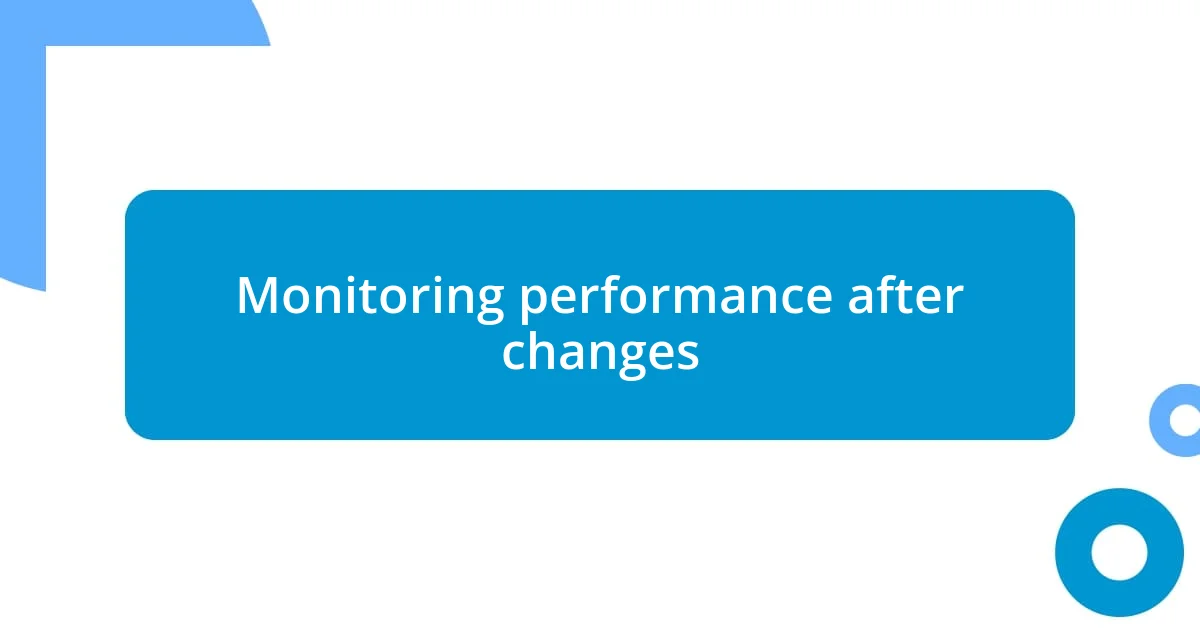Key takeaways:
- Understanding key website performance metrics, such as page load time and bounce rate, is crucial for enhancing user engagement and conversions.
- Implementing optimization techniques, like image compression and caching, can significantly improve website speed and user experience.
- Continuous monitoring and gathering user feedback are essential for identifying further improvement opportunities and ensuring ongoing website success.

Understanding website performance metrics
Understanding website performance metrics is essential, as these metrics are the heartbeat of your online presence. When I first delved into this world, I was amazed by how a few seconds could make or break user engagement; it’s fascinating to see just how critical load times have become. Can you believe that a one-second delay can decrease conversions significantly?
One key metric to consider is page speed, which refers to how fast your content loads on a user’s device. I remember the first time I analyzed my website’s speed using various tools. The results were eye-opening! It wasn’t just about how quickly the site loaded; it was about the impression it left on visitors. Slow load times made my site feel outdated and unprofessional—a stark contrast to what I aimed to achieve.
Another important aspect to explore is the bounce rate, which indicates the percentage of visitors who leave after viewing only one page. It hit me personally when I noticed a high bounce rate on my blog. I realized visitors weren’t sticking around—not because they weren’t interested, but because they couldn’t find what they were looking for quickly enough. Understanding these metrics transformed how I approached content and design, reinforcing the notion that every second truly counts in the digital space.

Identifying key performance indicators
Identifying key performance indicators (KPIs) is a crucial step in understanding how your website performs. I learned this the hard way after launching my site; at first, I was overwhelmed by the myriad of data available. Narrowing it down to a few essential KPIs helped me focus my efforts effectively.
Here are some pivotal KPIs to consider:
- Page Load Time: The time it takes for a page to display all its content. I was shocked to see how even a minor improvement in this metric drastically improved user retention.
- Bounce Rate: A reflection of user engagement; a high bounce rate can indicate that your content isn’t meeting visitor expectations. I remember revising my landing pages after discovering that many visitors left within seconds.
- Conversion Rate: The percentage of users who complete a desired action, like signing up for a newsletter. I find it motivating when I see this number rise after optimizing my call-to-action buttons.
- Average Session Duration: This measures how long users spend on your site. I often felt a sense of accomplishment when I managed to increase this, as it implied that users were finding value in my content.
- Traffic Sources: Understanding where your visitors come from can help tailor your marketing strategies. Analyzing these sources showed me which channels were worth investing in.

Analyzing current performance data
Analyzing current performance data is a game-changer for improving your website. I remember when I first dived into my site’s analytics; the amount of data was overwhelming, but focusing on specific performance metrics helped me make sense of it all. The moment I realized the significance of each click, each second users spent on my site, was when I truly grasped their impact on my website’s success.
One of the biggest takeaways from my analysis was identifying where users dropped off. I found myself poring over heatmaps and session recordings, which revealed users often missed critical features because they were buried within the design. It felt like finding hidden treasures in my analytics! By pinpointing these frustrating points, I successfully revamped my layout, leading to a significant drop in bounce rates.
After making changes, I continually monitored performance data to understand the effects of my adjustments. I vividly recall tracking the before-and-after metrics for page load times; a drastic improvement felt like a victory. I could see the correlation between faster load times and an uptick in user engagement, which gave me the boost I needed to keep optimizing and innovating my website.
| Metric | Data Before Optimization |
|---|---|
| Page Load Time | 4.3 seconds |
| Bounce Rate | 67% |
| Conversion Rate | 1.5% |
| Average Session Duration | 1:30 minutes |
| Traffic Sources | Organic: 40% |

Implementing optimization techniques
When I decided to implement optimization techniques, I had to let go of some long-held misconceptions. For instance, I thought adding more content would inherently boost my site’s performance. Instead, I learned that simplifying my website layout not only made it visually appealing but also improved loading times. It was like lifting a burden off my visitors; I could almost feel their relief as they had an easier time navigating my site.
One of the standout techniques for me was image optimization. I used to upload high-resolution images thinking they’d enhance user experience. But when I learned about compressing images without sacrificing quality, it was a revelation. Not only did my website load faster, but I also noticed that visitors stuck around longer. Have you ever felt the frustration of a slow-loading page? Trust me, optimizing images made all the difference in my performance metrics.
Additionally, I began employing caching techniques, which prepared my site to deliver content to repeat visitors swiftly. Whenever I saw returning users face less lag time, it was exhilarating! Implementing a simple caching plugin transformed the experience for my visitors. Seeing those numbers get better felt like a personal win; it reinforced my belief that even small changes can lead to significant improvements in performance metrics.

Monitoring performance after changes
To truly grasp the impact of my updates, I made it a habit to track performance closely after making changes. It was eye-opening to see how small tweaks, like adjusting image sizes or reducing page elements, led to immediate results in my metrics. I found myself refreshing my analytics dashboard multiple times a day—almost like a kid waiting for their birthday cake to come out of the oven. That sense of anticipation was palpable!
Each time the numbers showed improvement, I felt a surge of motivation. I remember the day my page load time improved from 4.3 seconds to under 2 seconds; it was like watching a racehorse break from the gates. Users seemed happier and more engaged, and I could almost visualize them browsing my site with newfound enthusiasm. Monitoring these changes reinforced my belief that performance metrics are not just numbers; they represent real people having real experiences.
I often ask myself how much those improvements truly affected my users. I can say that my bounce rate dropping from 67% to around 48% felt like a major victory, but even more rewarding was the influx of positive feedback. Hearing from users who appreciated a smoother experience made every hour spent analyzing data worthwhile. It became clear that continuous monitoring was essential—not just to measure success, but to ensure I could keep delivering an exceptional user experience.

Continuous improvement strategies
Continuous improvement is like a never-ending journey, and I’ve learned that establishing a cycle of testing and iterating is crucial. After each optimization, I set aside time to gather user feedback through surveys. It’s surprising how much insight I gained from just a few responses! One survey revealed that while my site was faster, some users still struggled with navigation. Addressing that feedback felt like unlocking a hidden door to enhanced user satisfaction.
I also embraced A/B testing as a key strategy. When I decided to test two different landing page designs, the results were illuminating. One version, with a more straightforward layout, significantly outperformed the other in engagement metrics. It was exhilarating to see data validate my instinctive choices! Have you ever doubted a design decision only to have the numbers back you up? That moment felt like a spotlight shining on the path forward.
Regularly revisiting my analytics has become an integral part of my routine. It’s not just about checking numbers; it’s about spotting trends and opportunities for further enhancements. I recall the thrill of noticing an uptick in return visits just after optimizing my site’s mobile interface. Seeing users return with purpose gives me a sense of fulfillment, like watching a recipe come together perfectly. This ongoing commitment to refining and enhancing my site nurtures my passion, ensuring that each visitor feels valued and engaged.

Tools for measuring performance metrics
When it comes to measuring website performance metrics, several tools have become my trusted allies. Google Analytics is often my first stop; its robust features provide insights into user behavior that inform my strategies. I remember the first time I explored the Audience Overview report; it felt like unlocking a treasure chest of data, revealing who my users were and how they interacted with my site. Are you familiar with the depth of insights Google Analytics can provide? It’s more than just numbers; it’s a narrative of your users’ journeys.
Another tool I frequently rely on is GTmetrix. With its clear breakdown of loading speeds and suggestions for improvement, this tool has saved me countless hours of guesswork. I still vividly recall running a report and discovering an unnecessary script that was slowing my site down. The satisfaction of not just identifying the issue, but fixing it quickly, felt like clearing a roadblock that had been frustrating my users. Have you ever had a similar lightbulb moment while analyzing performance? It can be incredibly rewarding.
Lastly, I can’t overlook the power of PageSpeed Insights. This tool helps me measure my site’s performance on both mobile and desktop, which is crucial in our mobile-first world. When I first implemented its recommendations, I saw my mobile load time drop impressively. I couldn’t help but smile when users began leaving heartfelt comments about their improved experience. It’s amazing how the right tools can transform metrics into meaningful connections with users. Have you seen the positive impact of using performance measurement tools in your own work? I truly believe they’re invaluable in navigating the complexities of web performance.













